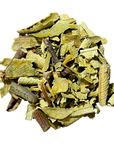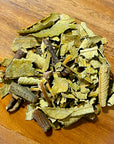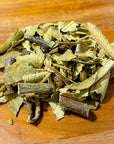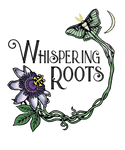


Yerba Santa
Botanical name: Eriodictyon californicum
^^Sustainably Wildharvested
Eriodictyon californicum, commonly known as California yerba santa, is a perennial shrub belonging to the Boraginaceae family. This plant is native to California and other parts of the southwestern United States, typically thriving in dry, coastal, and mountainous regions. California yerba santa is characterized by its thick, leathery leaves and clusters of small, tubular white to lavender flowers that bloom in the spring and summer.
In herbal medicine, yerba santa has been traditionally valued for its potential respiratory benefits, often used to support lung health and soothe coughs. The leaves can be prepared as a tea, tincture, or infusion, offering a slightly sweet and aromatic flavor profile. Historically, it has been used by Indigenous peoples for its reputed ability to alleviate symptoms of colds and allergies. Yerba santa is also recognized for its potential anti-inflammatory and antiseptic properties, making it a popular choice in herbal remedies for minor wounds and skin irritations.*
*These statements have not been evaluated by the Food and Drug Administration. This product is not intended to diagnose, treat, cure, or prevent any disease. For educational purposes only.



